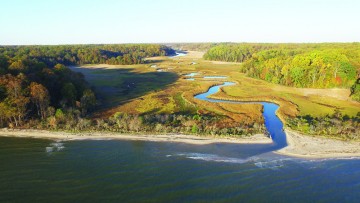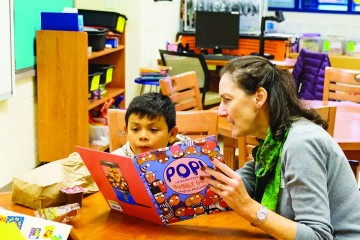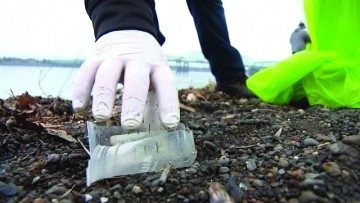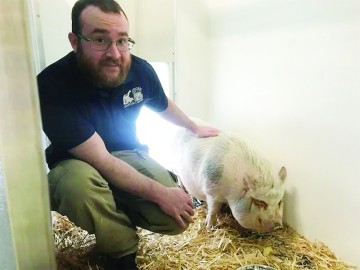Giving Thanks
“No matter what people tell you, words and ideas can change the world.”
We at Bay Weekly have so much to be thankful for this holiday season. We’re thankful for family and friends. We’re thankful for freedom of the press. We’re thankful for our health and good food. We’re thankful for dogs. The list is unending, but this year, what we’re especially thankful for are big ideas.
We’re thankful for problem-solvers — folks, who can spot an issue, visualize a solution and dive in to fix it.
Ideas inspire change, like Bruce Michalec’s idea to battle hunger in Chesapeake Country. This idea led him to open a food bank to help anyone who needed it. Michalec followed that idea until his death in October, and we — with thousands of others — are thankful to and for him.
Or like the problem-solvers at the Alice Ferguson Foundation. After battling with trash for more than five decades, these forward thinkers created an annual Trash Summit to stem the problem at its sources — and lead the way for other rivers.
We’re thankful for green spaces — and for conservation groups like the American Chestnut Land Trust that are saving land now and for the future.
Ideas sometimes come from love. Like the new Linda L. Kelley Animal Shelter in Prince Frederick, which gives strays a good start on their way to finding a home.
We’re thankful for all who go the extra mile to make sure kids learn to read, like the tutors at STAIR — Start the Adventure in Reading.
Beyond these five are so many more they could fill every issue of Bay Weekly. But this Thanksgiving, let’s start here.
Feeding the Hungry
Bruce Michalec
Let us give thanks for the man who believed that a person who needs food needs compassion.
Bruce Michalec — the first director and founder of the Anne Arundel County Food Bank — passed away this October at the age of 79 after a long battle with diabetes. He carved a legacy of compassion.
In four decades, Michalec expanded the food bank to serve more than 100 local pantries. He persevered through hardships of his own to grow the food bank from a small pantry in Deale to a 32,000-square-foot warehouse in Crownsville. He sacrificed his own time in the pursuit of a mission that eventually joined Feeding America and the Maryland Food Bank, doubling and then tripling food donations. As it expanded countywide, Michalec’s brainchild gave away more than $1.25 million in food annually. Last year — his final year as director — the food bank gave away more than 130 tons of food.
The legacy Michalec leaves behind reflects the legacy he received. He grew up surrounded by givers. His parents worked in military foreign aid and, at nine years old, he moved with them to the Philippines. Around 1960, Michalec came back to the U.S., where he — after a two-year stint in the army — went into the service industry in D.C.
“Bruce was so committed to helping people by then,” said Susan Thomas, the new director of the food bank. “He would feed the homeless out the back door of Shakey’s Pizza, where he worked.”
In 1986, Michalec moved to Annapolis and founded the first Anne Arundel County Food Bank to collect and distribute food to pantries and people. “When he started he didn’t have a lot of money,” Thomas said. “He would sometimes stay at the food bank if he had no where else to go. He knew what it was like to need help.”
Michalec did all he could for anyone who crossed his path. “Sometimes it was gentle nudges of encouragement,” Thomas said. “Sometimes it was paying electric bills or keeping a roof over someone’s head.”
That’s what he did for Marta Jones. In the late 1980s, Jones found herself on the doorstep of the food bank — then in Deale — asking for help. “I was anxious and embarrassed,” Jones recalled in her speech at Michalec’s memorial. “But Bruce came up to me, smiling, chatting, putting me at ease.”
He gave her a box of food and offered to pay her bills. A month later, he showed up to check in with even more food. “That was not the end of his kindness,” Jones remembered. “That Christmas, he again showed up at my door with toys for all four of my daughters. He was careful to come when they were asleep, so that the girls would think the gifts came from Santa.”
Michalec’s passion for charity was contagious and, almost 30 years later, Jones came full circle and started her own journey at the food bank.
Michalec’s unyielding dedication to giving lives on in the food bank. “He was like a beacon in the dark, drawing the forgotten out of the shadows and giving them hope,” Jones said. “We will honor his memory by making sure that the Anne Arundel County Food Bank remains a guiding light for those that need it.”
Express your thanks not only in feeling good but by taking action. Donate or volunteer and keep Michalec’s legacy moving forward: 120 Marbury Dr., Crownsville, 410-923-4255, www.aafoodbank.org
Preserving Our Landscape
American Chestnut Land Trust
Let us give thanks to the American Chestnut Land Trust for preserving green spaces for people and wildlife. Over 32 years, the Trust has been a bulwark during Calvert County’s most rapid growth and transformation from a farming and fishing community to a Washington, D.C., bedroom community.
A land trust conserves land by acquiring or keeping up property. The American Chestnut Land Trust — named for a survivor tree — has saved more than seven square miles from development — twice the size of Edgewater.

Instead of suburban sprawl, the rescued landscape is dotted with hiking trails, historical buildings and a working farm that donates to the Interfaith Food Pantry and hosts farmers markets. The first locally organized land trust in the county protects the land within the Parkers Creek and Governor’s Run watersheds, running from Prince Frederick to Port Republic.
“The land we manage shares the shore of Chesapeake Bay with Calvert Cliffs Nuclear Power Plant, Dominion Cove Point Liquified Natural Gas Terminal and hundreds of other land owners,” — including the estate of the late Tom Clancy, according to the Trust’s executive director Greg Bowen.
Keeping this high-value and high-dollar land pristine was possible only because Maryland and Calvert County created a range of specialized tools to preserve land, Bowen says.
One of those is Calvert’s Revolving Loan Fund, which lent the Trust its first land-purchase money. Repaid with interest in two years, the Loan Fund then funds new preservation purchases.
The newest addition to the Trust, a 405-acre property next to the Parkers Creek Preserve, was supported by Maryland Rural Legacy program, created in 1997 to protect large tracts of Maryland’s most precious cultural and natural resources. Prior to becoming part of the Trust, Holly Hill was the largest unprotected parcel in the watershed.
More than 1,800 acres of the trust’s property is leased from the Maryland Department of Natural Resources with the help of the Nature Conservancy. Private property owners have added another 1,100 acres.
To keep up its momentum, the Trust builds connections between people and the land. “You need broad public support,” notes Pat Griffin, president of the Trust board of directors. “Let folks in the community touch the land, and it will, in turn, touch them.”
Bowen explains how that happened. “We’ve given opportunities for people,” he says. “Our 22 miles of hiking trails, a working farm and canoe trips provide the community with a connection to wild lands.”
The organization also saves cultural locations such as The Hance-Chesley Cemetery, the oldest remaining cultural site on the land, and the Howard-White barn, which was restored by volunteers.
The Trust’s achievement is magnified by joining forces with other community land savers, including Calvert’s five other land trusts: Calvert Farmland Trust, Calvert Nature Society, Cove Point Natural Heritage Trust, Southern Calvert Land Trust and Patuxent Tidewater Land Trust.
“Working together, more can be accomplished for the good of the community,” Bowen says.
So what difference does all this make?
One difference is keeping the birds in our ecosystem.
“As the last remaining almost entirely undeveloped watershed on the Western Shore of Chesapeake Bay, Parkers Creek is a critical site for birds,” says David Curson, director of bird conservation at the National Audubon Society, Maryland-D.C. “Due to effective deer herd management over the years, Parkers Creek has developed a healthy dense understory layer of vegetation that supports higher numbers of forest-interior birds — such as the hooded warbler and Kentucky warbler — than other forest sites in Maryland.”
Bowen credits a great sense of community for how the organization is able to meet its mission. “A small group can accomplish anything,” he says.
Express your thanks by enjoying it yourself or volunteering with American Chestnut Land Trust land. Hike the trails, explore the historical sites and learn farming practices (and enjoy the harvest) at Double Oak Farm: 410-414-3400.
Changing Lives in 70 Minutes
Start the Adventure in Reading
Let us give thanks to Start the Adventure in Reading for teaching kids to read. Kids who can’t read drop out of school. Adults who can’t read don’t excel in the workforce. STAIR tutors change that 70 minutes at a time.
That’s all it takes to change a child’s future. And changing a child’s future means you’ve changed the world.

But those 70 minutes have got to come at the right time. That’s second grade, STAIR explains. Kids who don’t read at grade level by the end of the second grade have a 40 percent higher chance of dropping out of high school.
“Until the second grade, you learn to read. After that, you read to learn,” says Linda Barbour, STAIR director.
Those 70 minutes also must be repeated. Twice a week is ideal for the second-grade school year.
So twice each week for the school year, STAIR tutors meet one-on-one with their second-grade reader. Most volunteer tutors follow a structured program. Each session begins with out-loud reading, with tutors reading the three short books they’ve selected for the day while their student enjoys a healthy snack.
Next, they use flash cards to get their reader familiar and comfortable with simple words. Then comes phonics: sounding out words. The next step is reading together. To close, the reader chooses what to do: play games or write in their journal.
STAIR began in New Orleans in 1985. Now in its 13th year locally, STAIR has 180 tutors working in 10 schools with an 11th coming to Lothian Elementary in January. Eighty-five students are enrolled. Of the 429 graduates, the majority — 75 percent — are at or above reading grade level by the end of the school year.
“People see programs like ours as just do-gooders,” Barbour says. “But really, we are just people who want to see children grow up and be employed, and you need a high school education to do that. If we can get kids to read and grow up and graduate from high school, we’re helping everybody.”
Express your thanks by taking action: STAIR is recruiting volunteers to become year-long tutors in Lothian: Malena Ruland at Malena Ruland at [email protected]; www.stairannapolis.org.
Cleaning up Our Trash
The Alice Ferguson Foundation
Let us give thanks to the Alice Ferguson Foundation for picking up our trash and slashing the revolving cycle of waste in George Washington’s river — the Potomac.
Thirty years before, the foundation, which connects communities to the Potomac watershed, decided to clean up its bend in the river. That bend was a beacon for waste from the Anacostia-Potomac convergence 30 miles upstream.
In 1989, the Foundation tried to tackle the growing trash heaps by organizing its first cleanup. That cleanup was small, with just a few members of the community pulling bags of plastic and debris from the shores of Hard Bargain Farm and the Accokeek Foundation.
Year after year, no matter how much volunteers picked up, there was more trash fouling the river — the source of drinking water for Washington, D.C.
Sixteen years after the first cleanup, the foundation went to the source of the problem. In 2005, eight elected officials signed the first-ever Potomac Trash Treaty. The founding signers — including the mayors of D.C. and Alexandria — promised to support trash-reduction strategies. That treaty has now been signed by more than 150 organizations. The founders swore to reconvene annually. Thus the Potomac Trash Free Watershed Initiative was born.
“We needed a space where community leaders could meet with elected officials and non-profits,” said Lori Arguelles, president of the Foundation. “We created the Trash Summit for the entire region to make changes together.”

At the 2008 summit, trash like tires, gas tanks and aerosol cans provoked the Foundation to raise awareness about illegal dumping. That began the first Litter Enforcement Week, which was extended, three years later, to Litter Enforcement Month in April.
In 2009, D.C. passed the Anacostia River Cleanup Protection Act, which requires a five-cent fee on disposable paper and plastic bags.
“The bag fee was huge,” Arguelles said. “But we knew it would have little impact unless other surrounding jurisdictions got on the same page.”
Two years later, another jurisdiction jumped on the bandwagon as Montgomery County passed its five-cent fee on paper and plastic bags. That year, the annual Potomac River Cleanup had grown as large as a middle-sized city with 100,000 volunteers.
By 2015, the foundation’s litter-prevention campaign led to a 30 percent reduction in littering in D.C. neighborhoods.
“Last year we removed 1,287 bags of litter from Rock Creek alone,” Matt Fleischer of The Rock Creek Conservancy reports.
This year’s 12th annual Trash Summit brought the litter challenge to the business community. “We wanted to see businesses take the lead,” said program manager, Laura Cattell Noll. “We want to put the focus on plastic.”
This year 9,744 volunteers in 300 community cleanups pulled out 346,444 pounds of trash from the Potomac.
That trash contained 11,034 plastic bags, 9,726 plastic straws, 6,871 cigarettes and 862 tires.
Overall, the litter load hasn’t reduced since the first cleanup 30 years ago. What volunteers are finding less of, though, are plastic bags. “We’ve seen a 60 percent drop in plastic bag trash since the bag fees were passed,” Cattell Noll said. “That’s something created from the summits. It’s something to be proud of.”
Saving the Lives of Calvert Critters
Linda L. Kelley Animal Shelter
Let us give thanks for the new Linda L. Kelley Animal Shelter in Calvert County for saving the lives of animals and improving their level of care.
Named for a past county commissioner and animal lover, the Linda L. Kelley Animal Shelter’s first achievement is solving a problem.
Before the new shelter opened this month, Calvert, Charles and St. Mary’s counties all shared one over-stretched location: the Tri-County Shelter in Hughesville.

“Three counties had to rely on one government animal shelter in spite of substantial growth,” says Lynne Gillis, vice president of the Shelter’s Friends.
“This new shelter means that more animals will have a chance to find a home rather than being euthanized due to a lack of space. It makes the difference between life and death for so many healthy, adoptable dogs and cats.”
As well as solving a problem, Calvert’s new shelter — funded by Calvert County government at $1.58 million this year — features innovations in animal care and welfare.
Instead of the typical two zones, the Kelley Shelter has 27. These zones “allow us to isolate illnesses and prevent the spread of diseases to the rest of the population,” says Crystal Dowd of the shelter.
Isolation rooms for both dogs and cats further separate sick animals from the general population. Cages in the dog and cat quarantine rooms have privacy panels to help animals adjust to their new surroundings. Separate dog and cat corridors prevent possible unfriendly meetings.
Another care enhancement is medical evaluation of each animal as it comes into the shelter. Dog, cat, pig or pigeon, each animal is tested, vaccinated and — for larger animals — microchipped.
Kitty cat Prim’s apparent leg injury turned out to be a deformed paw. A dog with a skin problem that staff couldn’t solve got a lift to a local veterinarian for further care.
Animals who’ve received good care in shelter are more likely to be placed with a rescue group. It’s simple economics: Rescue groups have limited funds. The more the group must spend on each dog, the fewer dogs they can save. The cost of each animal’s medical care is one of the most expensive aspects of rescue work.
“When a partner shelter provides veterinary care before placing dogs with us, it enables Lab Rescue LRCP to take in more dogs,” says Wendy Finn, President of Lab Rescue of the Labrador Retriever Club of the Potomac. “Together, we can save more lives.”
Express your thanks by not only feeling good about the new shelter but also by taking action. The shelter needs volunteers. Dani Dickerson at 410-535-1600 ext. 8000.
